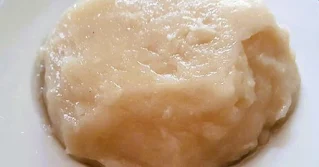Eating With Your Hands is Environmentally Friendly
Eating Funge with your hand instead of utensils is eco-friendly because traditional eating methods of eating with the right hand reduce plastic waste.
Use Funge in place of your fork and spoon to experience Angolan cuisine's rich and diverse flavors. Opting to eat Funge with meals instead of using a
fork and spoon is environmentally friendly because the traditional eating
method of eating with Funge involves using hands or a small piece of Funge
itself to scoop up the food. By avoiding using disposable utensils, especially
those made of plastic, you contribute to reducing plastic waste.

|
| Funge |
Embracing traditional eating habits is a mindful and eco-friendly approach.
Funge is a traditional and authentic side dish commonly served with classic
Angolan stews. The dish is made by cooking cassava flour in boiling water
until it reaches a stiff or firm dough-like consistency. The final product's
texture is similar to mashed potatoes but has a much firmer, sticky,
and denser texture.
It is worth noting that Funge is not to be confused with fufu, another popular
African dish made using starchy vegetables such as yams, plantains, or
cassava. The main difference between fufu and Funge is that fufu is
traditionally pounded while Funge is boiled.
The term Funge itself is derived from the Kimbundu language spoken in Angola. Funge refers to a starchy, dough-like dish typically made from cassava or maize flour in Kimbundu. Kimbundu is a Bantu language spoken by the
Kimbundu people, who are native to Angola. It is one of the most widely spoken
languages in the country. Over time, as Portugal established colonies in
Africa, including Angola, cultural exchange led to incorporating
African dishes, such as Funge, into Portuguese cuisine.
Portuguese is the official language of Africa's 7th largest county of Angola.
In 1483, the Portuguese arrived at the world's most expensive capital city, Luanda, Angola. Portuguese food, culture, and language still
significantly influence Angolans. Angola's name is derived from the Portuguese
from the title Ngola held by kings of the Ndongo. Ndongo was a kingdom in what
is now northern Angola.

|
| Making funge |
Funge is made with two simple ingredients: cassava flour and water.
Ingredients.
1 1/4 cups cassava flour (cassava flour is gluten-free)
1 teaspoon sea salt
2 cups water
Instructions.
Boil water in a large pot. In a large bowl, add salt and cassava flour and
mix the ingredients together well. Add this mixture to the boiling water and
keep stirring well with a wooden spoon until smooth. Reduce
the heat and cover for 15 minutes. To ensure the Funge is ready,
wait until it has solidified slightly. Too much water and your Funge will be
thin; too little water and the Funge will be too thick. Stirring constantly
until thick paste forms. Funge is eaten by squeezing small pieces lightly to
form a ball with the dough to scoop sauce. Use Funge in place of your fork
and spoon.
Eating Funge with hands instead of utensils is eco-friendly.
The production of utensils, especially those made of metal or plastic,
requires significant energy inputs. Individuals contribute to energy
conservation by forgoing utensils and aligning with environmentally conscious
practices.
Eating Funge with soups and stews and eliminating utensils aligns with
sustainable and environmentally friendly practices by minimizing waste,
reducing resource consumption, preserving local culture, and contributing to
energy conservation. Embracing such traditional eating habits is a mindful and
eco-friendly approach.



